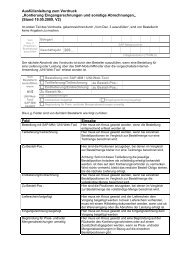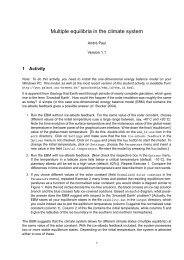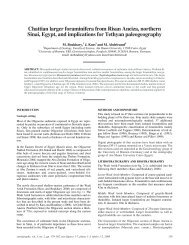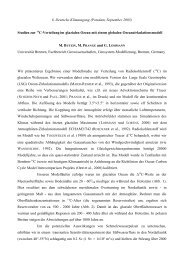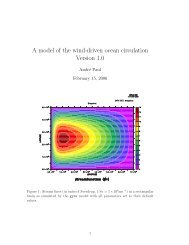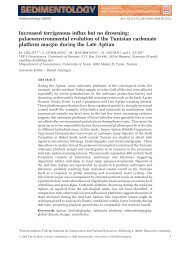Forschung im HLRN-Verbund 2011
Forschung im HLRN-Verbund 2011
Forschung im HLRN-Verbund 2011
- Keine Tags gefunden...
Sie wollen auch ein ePaper? Erhöhen Sie die Reichweite Ihrer Titel.
YUMPU macht aus Druck-PDFs automatisch weboptimierte ePaper, die Google liebt.
170Nanostructures for biosensing devicesFunctionalization of semiconductor nanowiresA.L. da Rosa, N.H. Moreira, Th.Universität BremenAbstractFrauenhe<strong>im</strong>,• Tailored nanodevices with a specific functionality,or combining various functionalities, can be designedby capping the surface of nanostructureswith organic molecules.• The design of such devices with opt<strong>im</strong>al performancerequires a deep understanding of theirphysical properties such as the investigation ofsurface defects and surface functionalization.• In this project we employ first principles densityfunctional theory to design hybrid semiconductornanostructures with specific functionality via surfacemodification and doping.• Equilibrium structures of semiconductornanowires functionalized with organic moleculesare investigated. We propose opt<strong>im</strong>al anchorgroups for functionalization of these wires.There is considerable technological interest incombining organic molecules with semiconductornanostructures in order to obtain hybrid materialswith novel properties, which includes highlyspecific sensors and new multifunctional devices.Nanostructured materials have large surface-tovolumeratios which offer a unique possibility ofenhanced sensitivity and selectivity. Chemicalspecies introduced onto the surface of such nanostructurescould then be employed to create novelhybrid multi-functional devices. Nowadays, theused sensing devices require large complexity andt<strong>im</strong>e-consuming sample preparation and offer l<strong>im</strong>itedsensitivity. Compared to two-d<strong>im</strong>ensional planardevices, where binding to the surface leads todepletion or accumulation of charge carriers onlyon the surface region, the charge accumulationor depletion in the one-d<strong>im</strong>ensional nanostructurestakes place in the bulk region of the structure,which gives rise to large changes in their electricalproperties. Such a feature is particularly desirablefor rapid and real t<strong>im</strong>e detection of biomoleculesand proteins. One of the crucial aspects for the realizationof such hybrid systems is the understandingof the semiconductor/organic interface.ZnO can offer many advantages, such asgood conductivity, many transport channels at thenanoscale, excellent chemical stability and biocompatibility.Surface modification of ZnO nanostructuresshould provide <strong>im</strong>mobilization of furtherattached biological or organic molecules throughcovalent binding. Due to the complexity of the systems,it is not always straight forward to obtain allaspects of ZnO/organic interface by exper<strong>im</strong>entalcharacterization. In this context, density functionalcalculations are a powerful tool for the quantitativeinterpretation of exper<strong>im</strong>ents, and can help to determinethe most stable binding groups, the geometryof the adsorbed molecules as well the electronicand electrical properties of the ZnO/organicsystem.We employ density-functional theory basedmethods, including first-principles and tight-bindingapproaches to investigate structural and electronicproperties of hybrid ZnO/organic nanowires. Wehave investigated the chemical interactions betweenZnO nanowire facets and several organicfunctional groups. Moreover we have investigateddopants in ZnO wires for spintronics applications.We have demonstrated the covalent functionalizationof (1010)-ZnO surfaces with carboxylicacids. We have found two thermodynamically stablesurface configurations: a monolayer coveragewith a bidentate chelating ligand and a halfmonolayercoverage with a bidentate bridging ligand(as shown in Fig.1). In both cases, the electronicband structures show the presence of covalentsurface/adsorbate interactions. Besides, anonbonding carboxylate character is verified for thebidentate adsorbate[2],[4].Besides we have calculated the atomic relaxationsand formation energies for neutral andcharged defects using an empirical potential alignmentprocedure. Oxygen vacancies and zinc interstitialshave been found the lowest energy defectsunder Zn-rich conditions, with oxygen interstitialsand zinc vacancies favored under O-rich conditions.Most defects have been found favorableon the surface of the wire, with exception of thecharged oxygen interstitials, which prefer inner positionsto allow a better charge accommodation observedthere. Besides, we have also investigatedthe interaction between oxygen vacancies and carboxylicacids, demonstrating that an oxidationreductionreaction may explain the suppressionof green luminescence bands exper<strong>im</strong>entally observedfor organic-coated ZnO nanowires[1].Finally we investigate the formation energies,electronic structure, and magnetic properties of N<strong>im</strong>purities in ZnO nanowires. While the subsurfaceposition is the preferential site for the N dopantsin bare nanowires, upon hydrogen passivation Natoms segregate to surface sites. Additionally wePhysik



